Only got 2 days to explore Kyoto? Don’t worry we have put together this itinerary to help you find the best things to do in Kyoto and the easiest way to see a good mix of sites in just 48 hours.
What you will find here
Why you should visit Kyoto
Japan is well known for being a country that respects and preserves its past and this is very evident in Kyoto. The city was Japan’s capital for over 1000 years and has more than its share of significant sites as a result.
By a stroke of good fortune, and the fact that a US Serviceman involved in the strike on Nagasaki had visited the city and could see its importance in Japanese history, Kyoto was spared and suffered little impact from WW2.
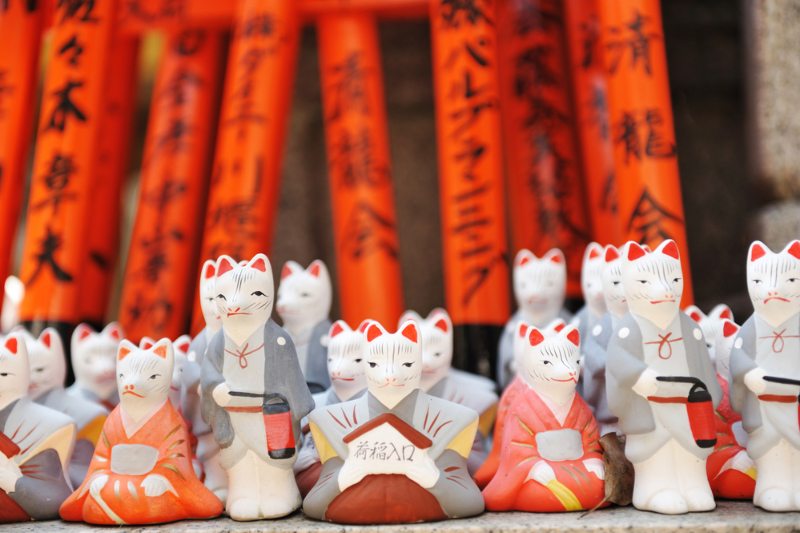
As a result, there are 17 UNESCO sites in the city area alone and 15 more nearby so you will need to hit the ground running if you plan to visit several of these.
Is it expensive to visit Kyoto?
Kyoto is a great city for budget travellers with so many of the most important sites carrying very low or even no entry fees. Added to this, just walking around the city streets taking it all in is one of our favourite things to do.
- The local bus system is also really affordable and easy to use with just a little research.
- You can also save plenty on food by dining in the department store food courts and convenience stores which have surprisingly good food.
- There are also no less than five organisations offering free walking tours, a couple are completely free, and the others expect a small donation. Check out Kyoto Free Guides as a starting point.
Why I think you should start your Japanese holiday in Kyoto
When we travel, we often like to begin our discoveries by exploring the past. Japan’s bright lights and technology might be what it is best known for these days, however, it is a place where tradition is a big part of everyday life. In Kyoto, that sense of tradition is everywhere.
Kyoto is a great place to find your feet in this amazing country before exploring further. With a population of about 1.5 million, it’s still a decent size city with plenty of things to do but it’s far more compact than Tokyo, making it a good stop for your first Japanese experience. It’s not as overwhelming as the capital.
If you don’t have long to spend in Japan, I also think a Kyoto/Osaka combination is a good option leaving Tokyo for a more extended visit.
How many days should you spend in Kyoto?
The itinerary here covers two days because let’s face it not everyone has a month to tour the country. We had four days here but lost our first day due to illness and spent the last day catching up with friends in the city so we really only had two days to explore.
I was surprised at how much you can see with just 48 hours. You just need to be organised and have a plan. If you can add a few more days, then please do, you won’t be disappointed. But on the other hand, don’t miss Kyoto just because you don’t have the luxury of extra time.
What are the unmissable things to do in Kyoto?
I think the following five things should go straight on your list.
- Strolling Gion either alone or on a tour
- Eating everything at Nishiki Market
- Heading to Yasaka Pagoda for sunset
- Visiting the Golden Palace
- Walking to eat least the halfway point at Fushimi Inari Shrine
You should also consider the best time of year to visit Japan for the best experiences.
This post may contain affiliate links. If you book via these links, we may make a small commission at no extra cost to you.
Day One in Kyoto
Places visited on Day One.
Arashiyama – Bamboo Grove – Tenryu-ji Temple – Exploring Nishiki Market aka Kyoto’s Kitchen – Walk along the Kamogawa River – Bars in Pontocho
Begin today at Kyoto central station. If you have not had breakfast, you can pick up something here. Take the train to Saga Arashiyama Station; it’s on the JR Sagano line.
Arashiyama Bamboo Forest
We started the day with the bamboo forest because the site is open 24 hours a day so you can get in and see this before the rest of the city wakes up. On a two-day itinerary, this highly recommended or you will just not get to see everything if you sleep late.
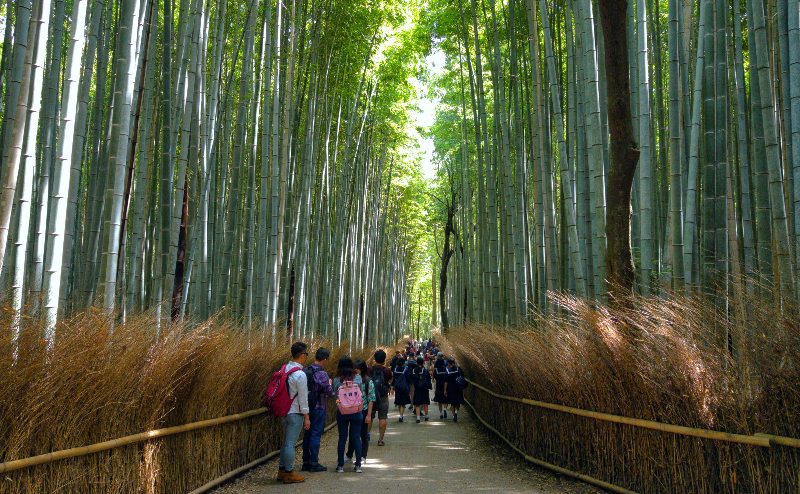
Many people do not realise that the Bamboo Forest is not a sacred site, although there is a temple right next to the forest. It’s just a very picturesque grove of bamboo.
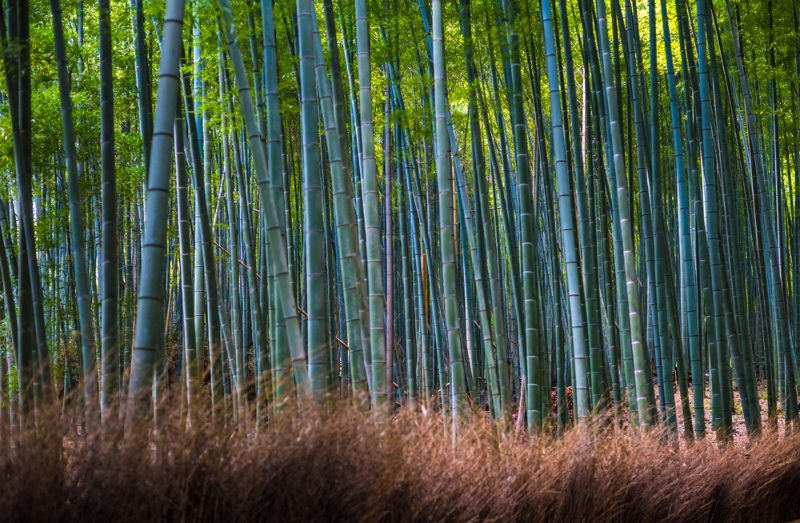
There is quite a lot to see in Arashiyama, arriving early will give you a little time to explore the rest of the area.
We decided to follow this walking route by Inside Kyoto, and it was excellent. But you can also book a guide.
Where: Arashiyama, Ukyo-ku
When: Arrive as close to sunrise as you can for some solitude.
How: The train takes about 15 minutes and then walk another 10-15 minutes. You can use your JR pass if you have one. Ether return via the same station or use Arashiyama Station.
Tenryu-ji Temple
This Zen Buddhist temple is one of the city’s UNESCO World Heritage Sites. The gardens were well worth the entry fee alone.
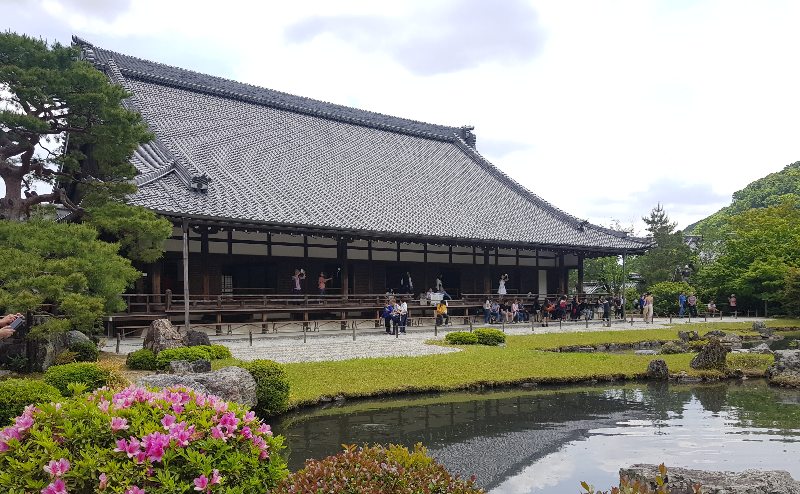
The gardens offered solitude that is not possible to find in the forest after 9am! Group tours and backpackers seemed to give the gardens a miss.
Where: Sagatenryuji Susukinobabacho, Ukyo Ward (at the beginning of the Bamboo Grove)
When: 8:30am-5:30pm
How much: ¥800
Another nearby attraction is the Kimono Forest. You will find it near Arashiyama Station.
Detour: If you are in Kyoto on a longer visit and a garden lover, you might like to head to the Okochi-Sanso Villa at the top of the Bamboo Grove which is home to a stunning garden created by a wealthy Japanese actor. For about ¥1,000 you explore the garden and also enjoy a free cup of tea and a sweet. It opens at 9am and is located at the far end of the bamboo grove.
Alternatively, visit the nearby Monkey Park Iwatayama.
Afternoon
From Kyoto Station, we took the train on the Karasuma Line to Shijō Station (3 mins) and then walked to the market (10mins). There is no direct bus.
Exploring Nishiki Market aka Kyoto’s Kitchen
For the last 400 years, this market has been providing locals with sustenance. We arrived just in time for a late lunch. The market runs the length of a couple of blocks an is undercover so a break from any bad weather.
It is considered impolite to eat while walking in the market and there is a warning on the website in English
Where: Nishikikoji-dori, Nakagyo-ku (between Teramachi and Takakura)
When: 9.30am-6pm
How: Short walk from Shijo, Karasuma or Kawaramachi Stations
These food tours are great if you want a learn more about the cuisine of Kyoto or want someone to help you navigate the market and food scene.
From Nishiki, it is just a 10-minute walk to the Kamogawa River
Walk along the Kamogawa River
Often referred to at the Kamo River, this is a lovely way to end your first afternoon in Kyoto. The path along the river is particularly beautiful in Cherry blossom season but we went a few weeks after that and enjoyed the lovely greenery.
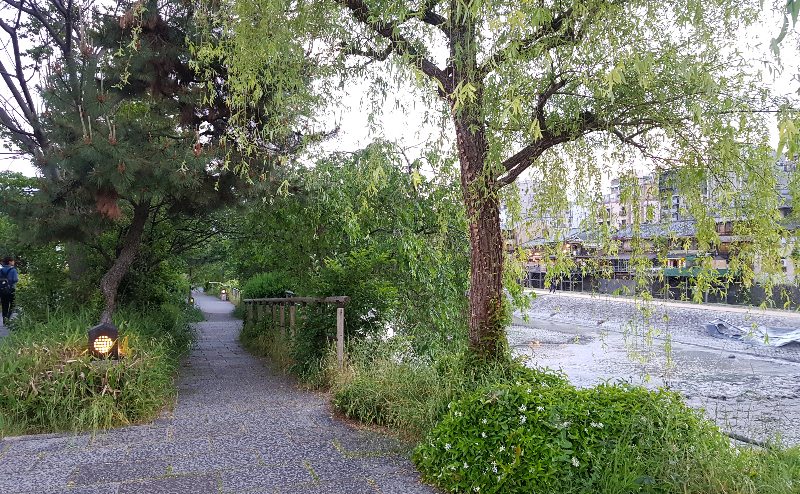
It’s a good spot for a picnic dinner if you are on a budget. Just pick up some goodies at the market before you head here.
Dinner at an Izakayas and Bars in Pontocho
After we had strolled the river, it was time for a drink. We took a walk down Pontocho street until we came to a bar called Hello Dolly
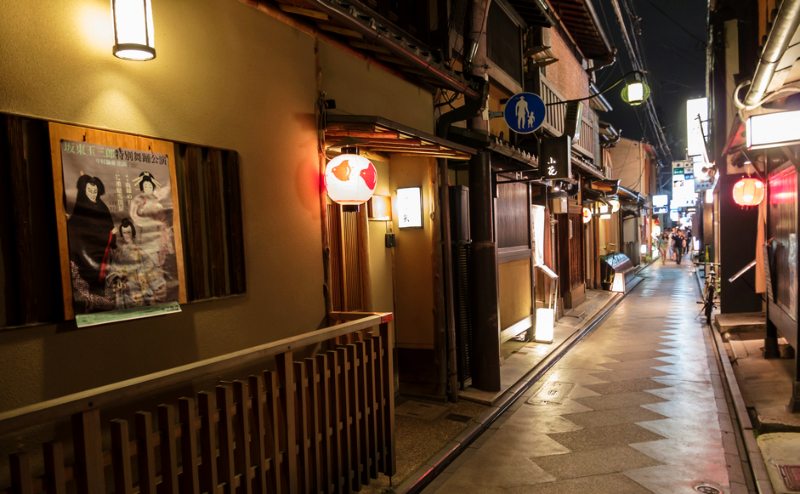
We ended the night at a Karaoke, don’t ask lol. A taxi was the only way home by the time we were done! Suffice to say the free gin served with your room booking may not have been a good idea
Day Two
Fushimi Inari Shrine – Kyoto Station – Kinkakuji Temple, Golden Pavilion – Gion walking tour – Yasaka Pagoda – Dinner at Kyoto Station area
Morning
Start your day at Kyoto Station, where you will join the train to Inari Station (JR line). The journey takes 5 minutes. The first direct train is at about 5.20am.
Fushimi Inari Shrine
Fushimi Inari Shrine was built in 711 and is one of the most photographed sites in Kyoto, is dedicated to the Shinto God of rice.
You will find it a short train ride away from Kyoto in the south of the city. The shrine is one of the most visited in Japan, so it’s essential to time your visit to this Shinto masterpiece unless you want to be lost in the crowd.
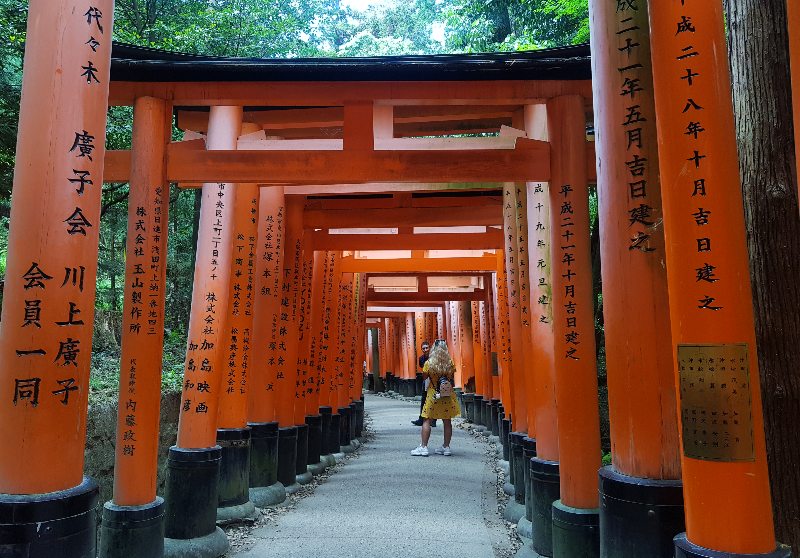
There are thousands of red (vermillion) torii gates which start at the bottom of a hill and head up. The official literature quotes 10,000 but apparently there are closer to 32,000 if you include the smaller gates.
Most people are pretty lazy or on a tight schedule and don’t walk past the midway point, so be sure to keep going if you want some photos with no people in them.
The full walk is 4km and includes 12,000 steps, we made it about 3km before we started to watch the clock and made our way back down. The view from the top is apparently quite impressive so give it a go if you have time.
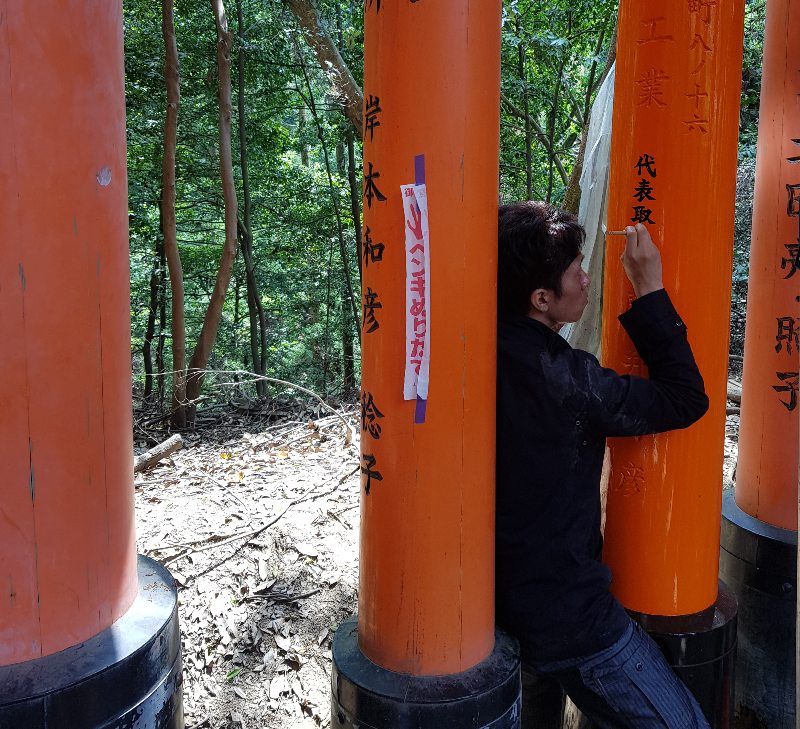
Individuals and business pay between 400K and 1.5 million Yen for lettering to be placed on a gate for a period of 10 years. Usually, it is the name of the donor and the date.
Where: 68 Fukakusa Yabunouchicho, Fushimi Ward,
When: The site is open 24 hours a day. It is busiest from 10am -5pm
How: 5 minutes by train from Kyoto Station
Cost: Free
Kyoto Station
You have by this stage been to the station a couple of times, but now it’s time to explore. Head up to Level 15, for the observation area where you can look out over the city. You can take the elevator in Isetan or the stairs at the station.
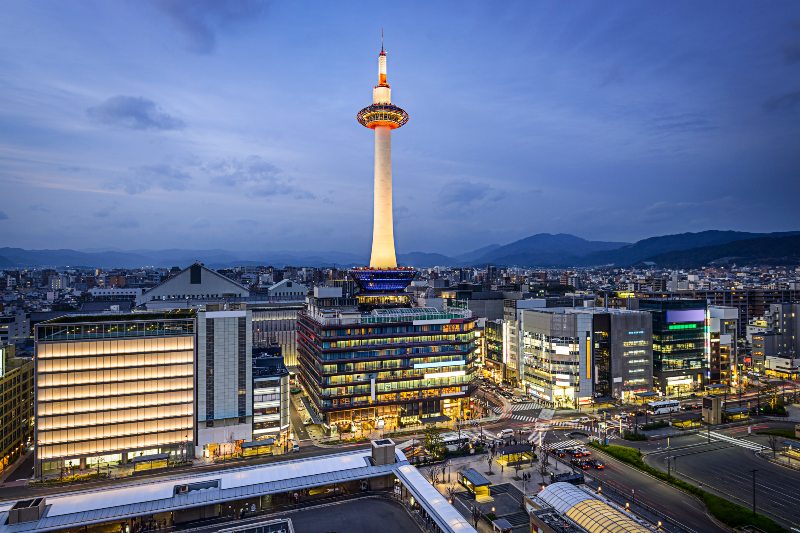
While you are here get yourself some lunch from one of the many outlets on level 11-15 of Isetan. If your budget is tight a bento box from the supermarket in the basement of the station is a great choice.
It’s also worth heading back to the observation area at night to capture the tower lit up.
From Kyoto station take the #101 bus to Kinkakuji Temple.
Kinkakuji Temple, Golden Pavilion
Built in 1397 as a private home for an aging emperor. Kinkakuji was transformed into a temple by his son after his death. A fire destroyed the first temple, but it was completely rebuilt in 1955.

I did not find the gardens here as impressive as others, and we only visited for about 30 minutes.
The temple is popular, but crowds seem to move quickly and in an orderly fashion. People pose for their photos and move away to the next vantage point.

These Japanese visitors were being photographed from above so that the Gold temple was visible in the foreground.
Opening Hours: 9 am – 5 pm
Admission: 400 yen – check website for full details
How: From Kyoto Station, take the #101 bus or the #205 (but NOT the rapid bus).
Tip: If this is your first bus ride, be sure to stand in the right line as well as the right stand. We queued in the wrong place and missed our bus. The lines are marked on the ground, so look down!
When you have finished here head back to the main road and take bus 59 for 5 minutes to Ryoanji Temple.
Ryoanji Temple
Ryoanji is a Zen Temple best known for its rock garden. If you are lucky you will hit a quiet time, and some “zen” will be possible but, in peak seasons it can be hard to find. Visit late afternoon like we did and it is relatively uncrowded.
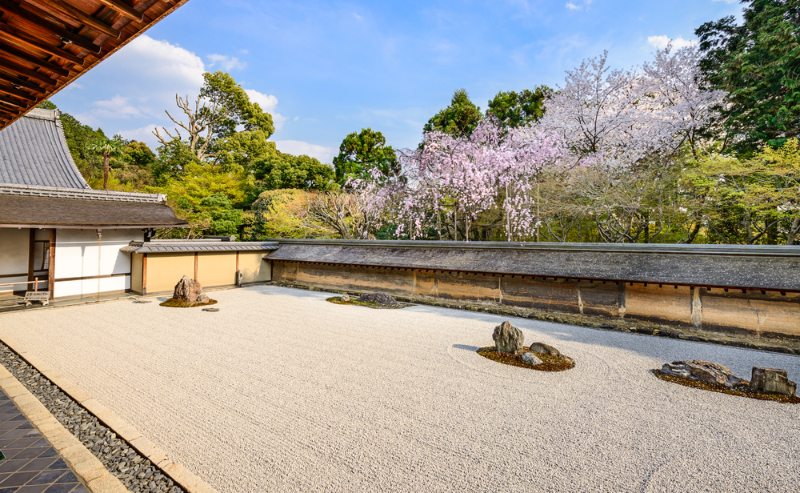
There are 15 rocks in the garden, but when you are seated observing it, no matter where you sit, you can only see 14 of the rocks. Very clever! Be sure not to miss the mirror pond and the rest of the garden.
Where: 13 Ryoanji Goryonoshitacho, Ukyo Ward, Kyoto,
Opening Hours: 8am-5pm (winter closes 30 mins earlier)
Admission: 500 yen – check website for full details
Once you are done walk about 7 minutes to Ritsumeikan Daigaku mae and catch the #51 bus to Gion-Shijo Station.
Recommended tours for covering lots of temples in one day
You can save some stress by booking one of these guided tours, they include transport, commentary and tips for photography.
Exploring Gion and Higashiyama
We have done lots of free walking tours around the world and while we all know that are not all are actually mean to be free, they are well worth the expected tip. The Gion Free tour by Tokyo Free Tours takes about two and a half hours and explores the Gion and Higashiyama areas.
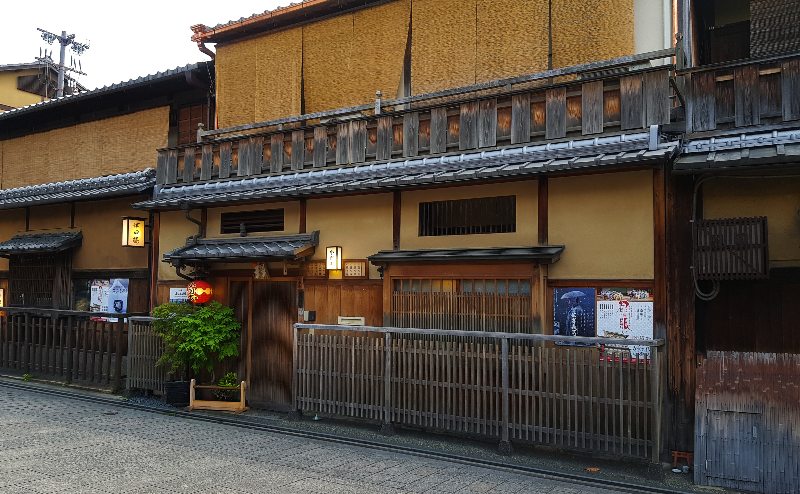
The tours are not on a set schedule as the guides are volunteers, available dates are listed on their Facebook page and you sign up there. Taking this tour, if available is a great way to learn about the history if the area. The tour finishes at my favourite photo spot in the city, Yasaka Pagoda.
Walking around Kyoto’s Gion district is one of the top things to do while visiting Kyoto. It is best known as being home of Japan’s Geishas. Lots of people don’t understand the role of the Geisha; they are highly trained traditional entertainers who are skilled in art, singing and dance. They work in some of the restaurants and bars in the district. They are not sex workers.
Please don’t snap photos of Geishas without permission, if you do want to take a picture do it from a distance; it’s disrespectful to get too close or harass them.
You might also like to take a guided walking tour or food experience in Gion.
Gion is a very traditional area, wandering along Hanamikoji Dori feels like stepping back in time. The traditional wooden houses look just as they did hundreds of years ago.
If you have not joined the tour, you can explore Gion alone and then just follow google map directions to Yasaka Pagoda; it’s about a 10-minute walk.
Yasaka Pagoda
The stunning 5 story Yasaka Pagoda is 46m tall pagoda and is over 600 years old. It is one of the most popular spots to photograph in the city.
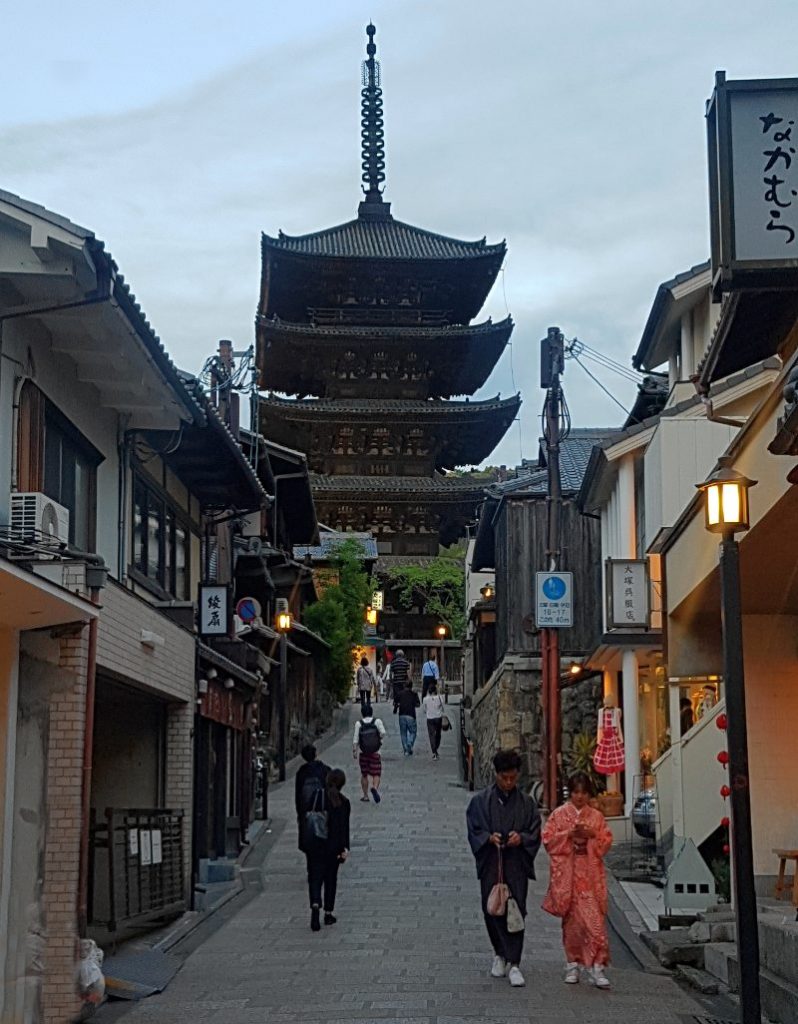
Where: 13 Ryoanji Goryonoshitacho, Ukyo Ward, Kyoto,
Opening Hours: 8am-5pm (winter closes 30 mins earlier)
Admission: 500 yen – check website for full details
Tips for travelling to Kyoto
When’s The Best Time Of Year To Visit Kyoto?
The best times are March, April, and May for Spring or October and November for the fall colours. We visited in early May and the weather was quite warm but not too bad. The cherry blossoms were gone but things were lovely and green.
Cherry Blossom season comes at a cost with very expensive accommodation and large crowded at the temples and other sites. Winter sees snow, and it can look quite beautiful if you are not afraid of the cold.
How to get to Kyoto
There is no airport in Kyoto, so you need to fly into either Tokyo or Osaka. If you are visiting from Australia, there are direct flights into Osaka (Kansai KIX) with Jetstar and Qantas. Other airlines offer a stopover service from Australia (Singapore or KL usually). From the US American Airlines fly direct from several cities.
A fast train from Osaka will take 75 mins (JR Limited Express Haruka)
If you are landing in Tokyo, it is about 3 hours by train from Narita airport
Getting around Kyoto
Buses
We made good use of the bus system in Kyoto. We found them easy to use, and most signage is bilingual. Google maps work well for buses and scheduling, and we used this first on most occasions.
You can use an IC card for most public transport in Japan, or you can buy a daily ticket from the ticket office near the bus station at Kyoto Station.
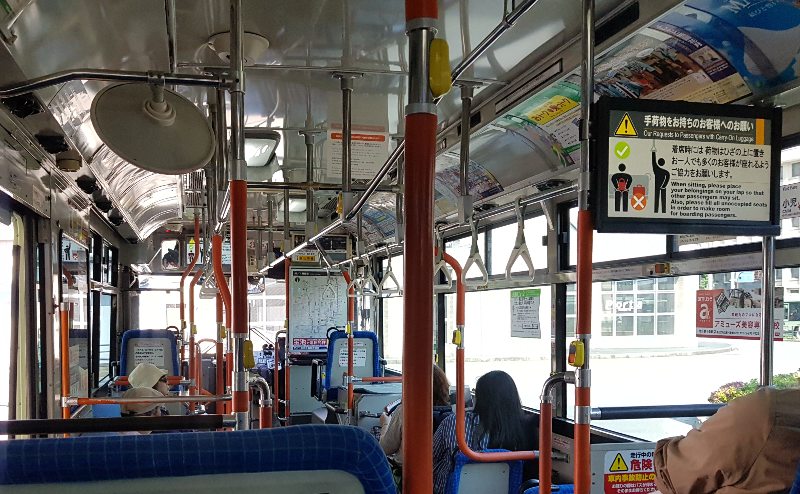
There are a number of passes available, its best to talk to the staff at the office for the current offers and pricing. They have several English speaking staff, and the queue for English speakers was signposted on our visit. The man who helped me on my first day mapped out the best passes based on what I said I wanted to see.
We downloaded the HyperDia app for train timetables and maps.
Trains
If you are only visiting Kyoto, there is no need to buy a JR (rail) pass. However, if you are moving around the country, then a pass might be great value, but you really need to do the math. Sort this out early because you can not buy your pass once you arrive. It needs to be purchased before you leave home.
We were visiting Hiroshima and Tokyo on this trip, so it made sense for us. You can use your JR pass on services to both Inari and Arashiyama.
Taxis
Japans taxis are known for being expensive, but we used them a couple of times and found them reasonable. Taking a taxi in Japan is an experience. The drivers and impeccably dressed, the cars clean, and there is an etiquette to taking a cab here. For example, you do not open or shut the doors; the driver controls this and only opens the door once you have paid. There is a taxi app that you might find useful.
The city is relatively flat too so suitable for cycling if that’s your thing.
Where to Eat in Kyoto
While Kyoto has a strong food culture and is the home to many fine restaurants on this mother-daughter trip food was not a big focus. We were watching our budget and mainly ate at moderate or budget restaurants.
Places like:
- Takashimaya Department Store Food Basement
- Lawsons and 7 Eleven convenience stores
- Isetan Department Store
- Porta Dining at Kyoto Station
You can also save money, making lunch your main meal when there are many great specials for business lunches.
Where to Stay in Kyoto
Choosing where to stay was our hardest decision. Was it best to be near the atmospheric Gion area or the nightlife and dining variety in Shinkyogoku or is the convenience of the station best. On a short visit, I think the station has to win. It will make exploring places like the Bamboo Grove and Inari Temple much more quickly than other locations.
Resi Stay Cotorune Kyoto Apartments
We stayed at Resi Stay Cororune on our last visit, and I am sure we will stay again. It was just a 5-minute walk to the Kyoto Station, making it very quick to get around the city.
The property is only a couple of years old, super clean and well laid out. It features a communal living area that overlooks a small zen-like garden, kitchen, laundry and small smoking room.
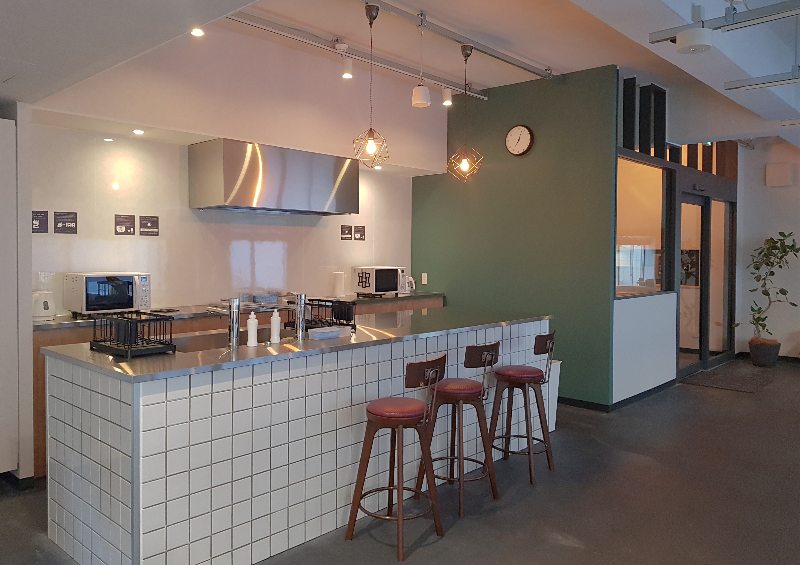
There are both Japanse style and western style rooms and also rooms with kitchens and larger family rooms.
Read other reviews on Tripadvisor or check prices on Booking.com
Hotel Granvia Kyoto
The Granvia Hotel is a 15 story property in the Kyoto Station complex. If you fancy a bit of comfort and the added benefit of not dragging your bags anywhere. Right on your doorstep is 11 floors of shopping and dozens of restaurants.
The hotel features a pool and fitness centra along with 8 restaurants on-site. Rooms range in size and style from large double rooms to family rooms and other special suites. All the rooms are large by Japanese standards. I would be very happy to stay here.
Read other reviews on Tripadvisor or check prices on Booking.com
Hotel Resol Kyoto Kawaramachi Sanjo
If you like the idea of staying in the centre of the nightlife, then this hotel is perfect, it’s just a short walk from Pontocho and Kiyamachi where you will find dozens of great bars and Izakayas. Sanjo Station is a seven-minute walk away. Also nearby is Nishiki Market and the main shopping area of the city.
The rooms are decorated in local style, with Tatami flooring. There are western beds and a small table and chairs. The standard room is on the smaller size, but the superior rooms are quite large. Accessible rooms are available.
Read other reviews on Tripadvisor or check prices on Booking.com
Got more than 2 days in Kyoto
Add some of these spots if you have more time in this magical city.
Kyoto Tower
Check out the view from Kyoto Tower – the observation deck sits 131 metres above the city making the tallest viewpoint. On a clear day, you can see to Osaka.
Kyoto Imperial Palace
Before moving to Tokyo in 1868, this palace was the primary residence of the Japanese Imperial family. You can take a free guided tour of the palace grounds and gardens – no bookings are necessary.
Kiyomizu-dera Temple
This was one spot we were really sad to miss. Unfortunately during our visit, it was closed for renovation. I would do my best to include it if you can.
The Philosopher’s Path
If you visit during cherry blossom season, you will most certainly want the Philosopher’s Path on your list. The stone path runs along a canal lined with cherry trees. Even at other times of the year, this is a beautiful walk and well worth an hour or two.
Find a hotel in Japan
Booking early is essential to get the best choice for peak seasons like Cherry Blossom or Golden week. I often use booking.com because may hotels can be cancelled at no cost if your dates change.
Booking.comHeading to Tokyo? Check out our advice for first time visitors.
Have a question about something here? Want advice for planning your visit? Head to our Facebook page and we will do our best to help.
Save our 2 days in Kyoto Itinerary to Pinterest



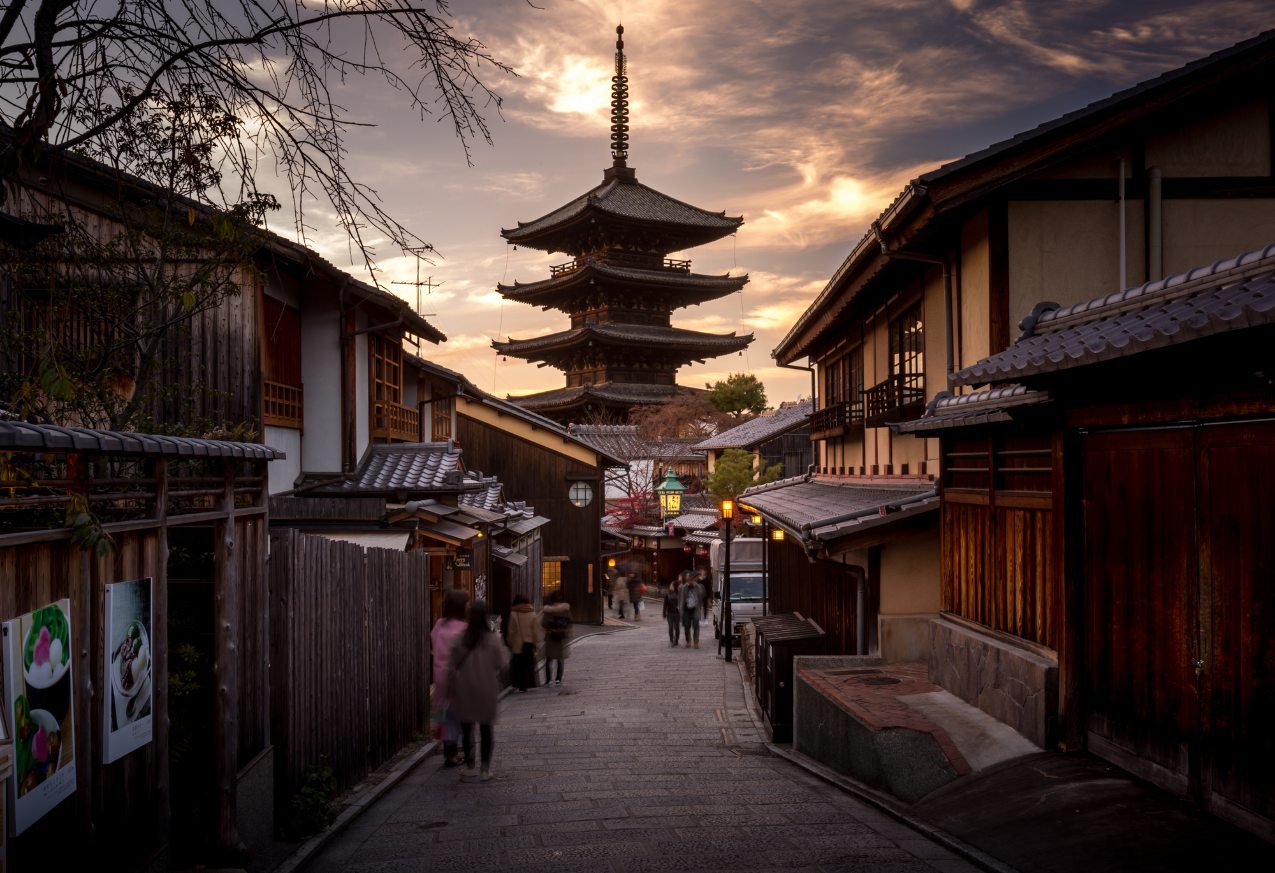
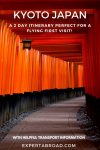
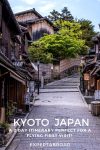
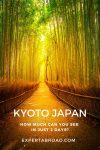
After study a few of the blog posts on your website now, and I truly like your way of blogging. I bookmarked it to my bookmark website list and will be checking back soon. Pls check out my web site as well and let me know what you think.
I as well as my friends were found to be taking note of the nice information from your web site then quickly I had a terrible suspicion I never expressed respect to the site owner for them. Most of the ladies are already for that reason glad to read them and have in fact been enjoying those things. Appreciation for truly being indeed considerate and also for making a decision on this sort of incredibly good subjects most people are really needing to be aware of. Our own honest regret for not expressing gratitude to you earlier.
Wonderful blog! I found it while browsing on Yahoo News. Do you have any tips on how to get listed in Yahoo News? I’ve been trying for a while but I never seem to get there! Appreciate it
you are in point of fact a good webmaster. The web site loading pace is incredible. It sort of feels that you’re doing any distinctive trick. Also, The contents are masterwork. you have performed a excellent activity on this matter!
I am perpetually thought about this, thanks for posting.
Valuable information. Fortunate me I found your site by chance, and I’m shocked why this coincidence did not happened in advance! I bookmarked it.
The next time I read a blog, I hope that it doesnt disappoint me as much as this one. I mean, I know it was my choice to read, but I actually thought youd have something interesting to say. All I hear is a bunch of whining about something that you could fix if you werent too busy looking for attention.
Hello, you used to write magnificent, but the last few posts have been kinda boringK I miss your super writings. Past several posts are just a little out of track! come on!
I got what you intend, appreciate it for putting up.Woh I am glad to find this website through google. “Money is the most egalitarian force in society. It confers power on whoever holds it.” by Roger Starr.
you are in point of fact a just right webmaster. The site loading speed is incredible. It sort of feels that you are doing any unique trick. Furthermore, The contents are masterpiece. you’ve done a wonderful process on this subject!
Keep functioning ,fantastic job!
Hi! Would you mind if I share your blog with my twitter group? There’s a lot of people that I think would really appreciate your content. Please let me know. Many thanks
We’re a gaggle of volunteers and opening a brand new scheme in our community. Your web site offered us with helpful information to paintings on. You have performed a formidable process and our whole group can be grateful to you.
I¦ve recently started a blog, the information you offer on this web site has helped me tremendously. Thanks for all of your time & work.
There are some interesting deadlines in this article but I don’t know if I see all of them heart to heart. There is some validity however I’ll take maintain opinion until I look into it further. Good article , thanks and we wish extra! Added to FeedBurner as well
This is the right blog for anyone who wants to find out about this topic. You realize so much its almost hard to argue with you (not that I actually would want…HaHa). You definitely put a new spin on a topic thats been written about for years. Great stuff, just great!
magnificent points altogether, you just gained a brand new reader. What would you suggest in regards to your post that you made a few days ago? Any positive?
Hmm it seems like your blog ate my first comment
(it was super long) so I guess I’ll just sum it up what I had written and
say, I’m thoroughly enjoying your blog. I too am an aspiring blog blogger but
I’m still new to everything. Do you have any tips for first-time blog writers?
I’d really appreciate it.
Hey there! Do you use Twitter? I’d like to follow you if that would be okay. I’m undoubtedly enjoying your blog and look forward to new posts.
I don’t ordinarily comment but I gotta state thankyou for the post on this special one : D.
Hey there! Do you know if they make any plugins to safeguard against hackers? I’m kinda paranoid about losing everything I’ve worked hard on. Any recommendations?
I saw a lot of website but I believe this one contains something extra in it in it
As I web site possessor I believe the content material here is rattling wonderful , appreciate it for your hard work. You should keep it up forever! Best of luck.
Those are yours alright! . We at least need to get these people stealing images to start blogging! They probably just did a image search and grabbed them. They look good though!
I was just looking for this information for some time. After 6 hours of continuous Googleing, finally I got it in your web site. I wonder what’s the lack of Google strategy that do not rank this kind of informative websites in top of the list. Normally the top sites are full of garbage.
What is Aizen Power? Aizen Power is an all-natural supplement to improve overall male health.
A lot of thanks for your whole work on this web page. Kim takes pleasure in making time for research and it’s easy to see why. A number of us notice all relating to the lively manner you offer effective things by means of this website and therefore invigorate participation from some other people about this situation and our own child is really becoming educated a whole lot. Take advantage of the remaining portion of the year. You have been performing a dazzling job.
Outstanding post, you have pointed out some superb points, I besides believe this s a very superb website.
Regards for all your efforts that you have put in this. very interesting info .
Hey! Do you know if they make any plugins to safeguard against hackers? I’m kinda paranoid about losing everything I’ve worked hard on. Any recommendations?
What is Java Burn? Java Burn, an innovative weight loss supplement, is poised to transform our perception of fat loss.
It’s a shame you don’t have a donate button! I’d definitely donate to this excellent blog! I guess for now i’ll settle for book-marking and adding your RSS feed to my Google account. I look forward to new updates and will talk about this site with my Facebook group. Chat soon!
Very great post. I just stumbled upon your blog and wanted to say that I’ve really loved browsing your weblog posts. After all I will be subscribing for your feed and I am hoping you write again very soon!
Howdy! Do you use Twitter? I’d like to follow you if that would be okay. I’m absolutely enjoying your blog and look forward to new posts.
What Is LeanBiome? LeanBiome, a new weight loss solution, includes beneficial strains of gut bacteria that work fast for weight loss.
There is noticeably a bundle to know about this. I assume you made certain nice points in features also.
The next time I read a blog, I hope that it doesnt disappoint me as much as this one. I mean, I know it was my option to read, but I really thought youd have something attention-grabbing to say. All I hear is a bunch of whining about something that you might repair if you werent too busy searching for attention.
Hi there, You have done a great job. I will definitely digg it and personally suggest to my friends. I am sure they will be benefited from this web site.
I think other web site proprietors should take this web site as an model, very clean and fantastic user friendly style and design, as well as the content. You’re an expert in this topic!
What i don’t realize is actually how you’re not actually much more well-liked than you may be right now. You’re so intelligent. You realize therefore significantly relating to this subject, made me personally consider it from numerous varied angles. Its like women and men aren’t fascinated unless it’s one thing to do with Lady gaga! Your own stuffs nice. Always maintain it up!